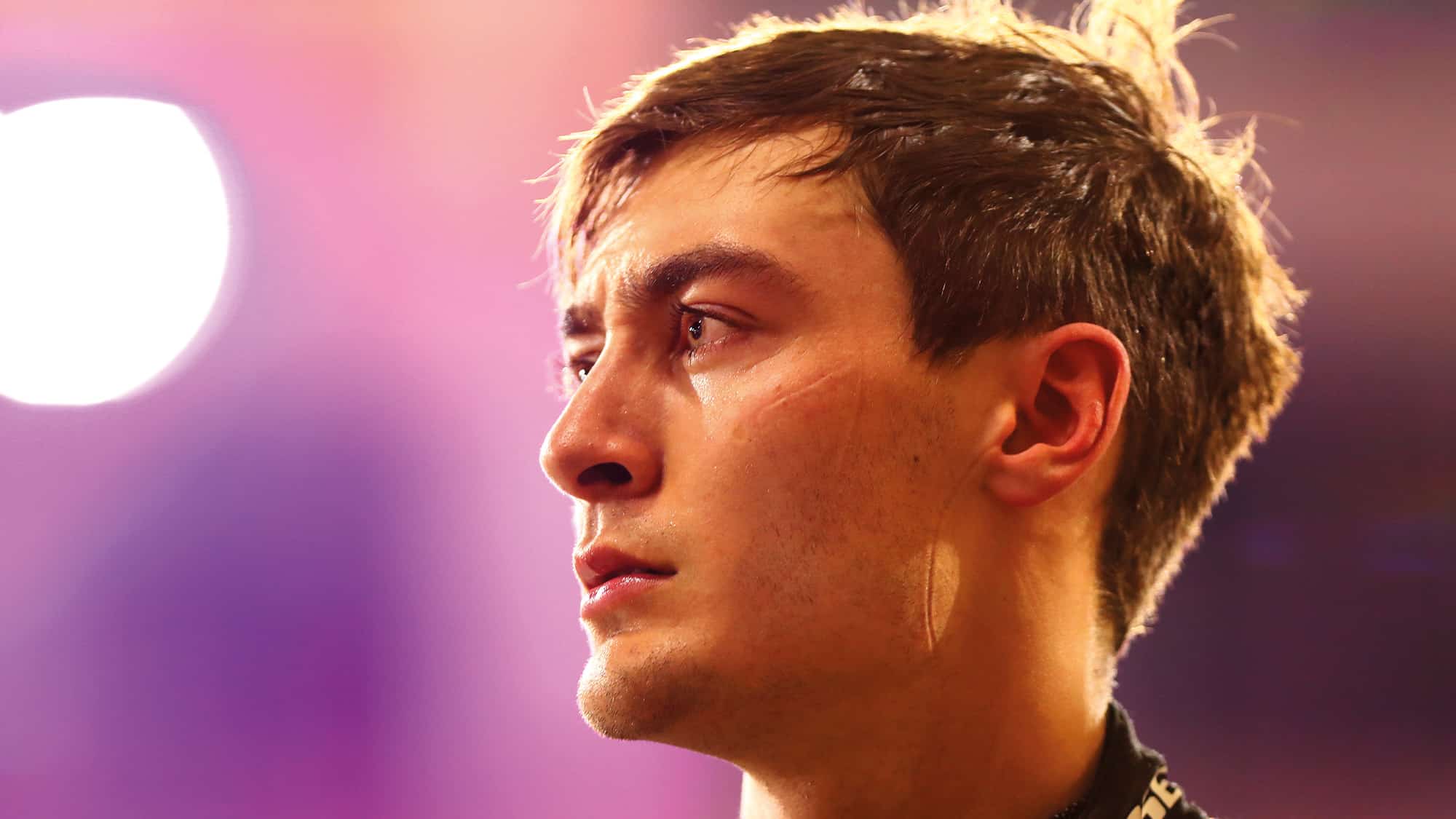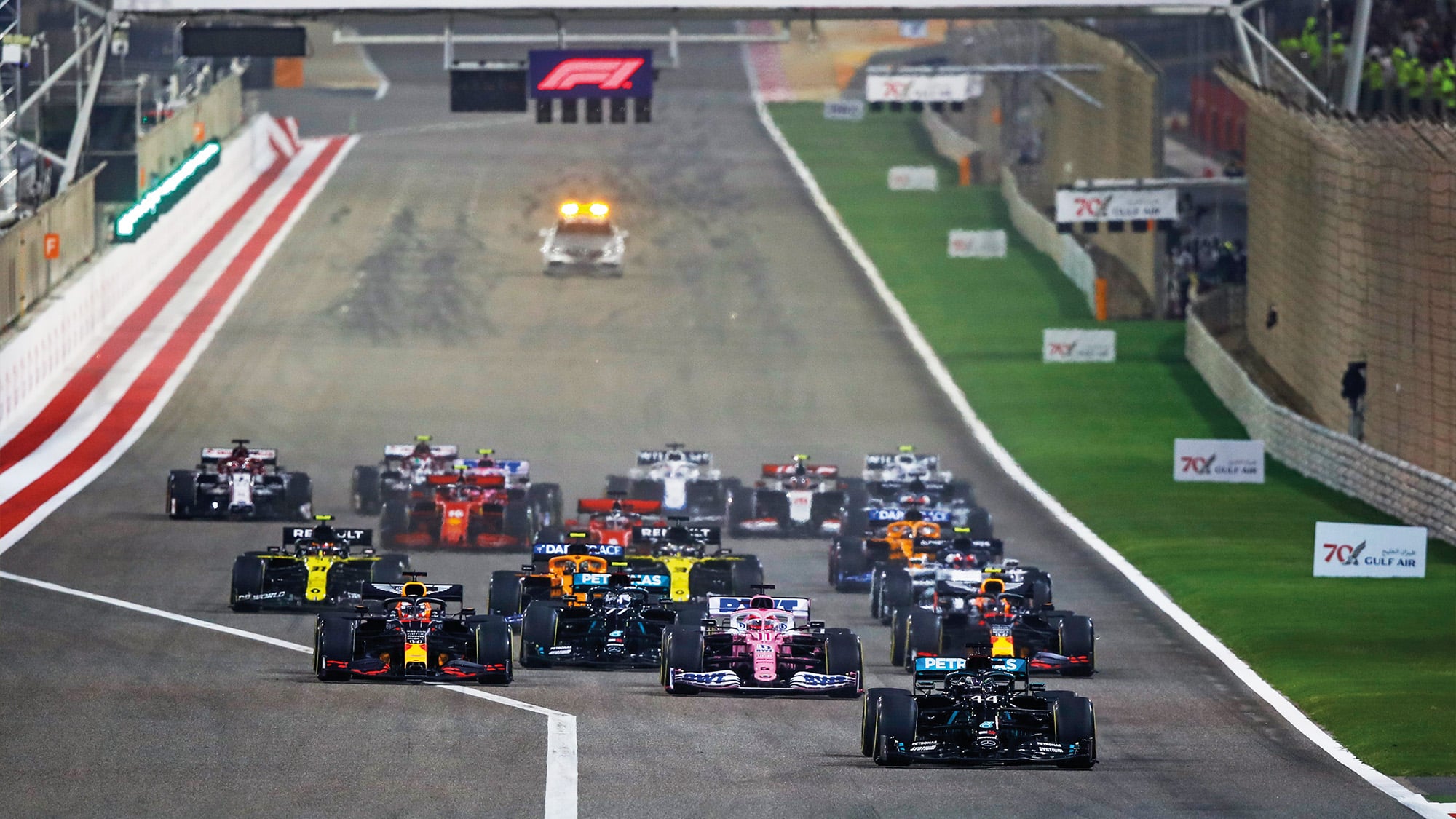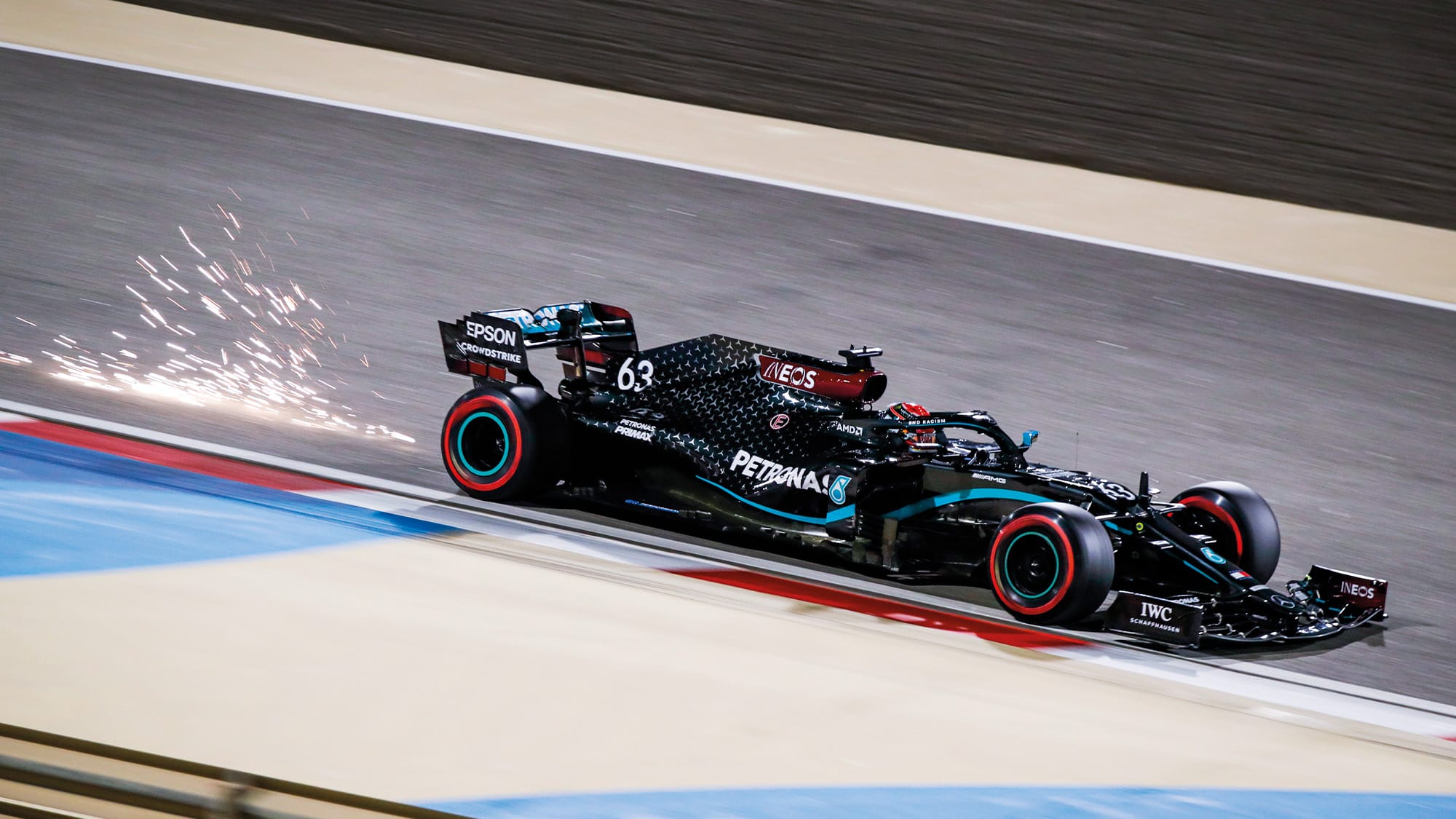Russell's rapid rise and fall: 2020 F1 season draws to a close
Formula 1 can be a cruel sport. When it gave a promising Briton a dream chance, only bad luck prevented an historic upset. Mark Hughes looks at the factors behind George Russell’s superb Mercedes cameo

When Hamilton was struck by Covid, Russell got the dream call-up to handle the champion’s car
Dan Istitene/F1 via Getty Images
George Russell travelled to the season-ending Middle East triple-header more in hope than in expectation. Williams had provided him with a better car in his 2020 sophomore season than it did for his rookie year, when it invariably wasn’t even able to compete with the next slowest car and his only competition was with his team-mate Robert Kubica. This year he’s at least been able to mix it with the Haas and Alfa Romeo teams – and the feasibility of an over-delivering presence in the Q2 part of the grid is much greater. That and getting his first points on the board have been realistic targets. He’d yet to achieve the latter as we headed into these last three races and that bugged him, for he is a super-competitive individual, very straightforward, very results-orientated. His spinning out behind the Imola safety car when on the verge of doing that was for him a devastating blow.
There had been a worrying bubble of speculation a few weeks earlier that Williams might be looking at taking Sergio Pérez
in Russell’s place as the Mexican shopped around for a drive. It was a tempting prospect for a Williams team which, even under its new ownership and with its debts cleared, doesn’t have money to spare. Pérez is a top driver and brings sponsorship as well. All Russell can supply is speed and ambition. But Williams itself ended the speculation, doubtless with an eye also to its engine supplier Mercedes. Russell is a junior Mercedes driver. His first proper run in a Mercedes came in 2018 before he’d made his F1 debut – at a general test at the Hungaroring. He went fastest, eclipsing Kimi Räikkönen’s Ferrari.
“Russell’s shoulders would hurt as he had to drive hunched”
In between winning that year’s F2 championship he’d sat in on engineering debriefs at Mercedes, and came to have enormous respect for just how hard Lewis Hamilton worked and his level of understanding. George sat and learned. It has all fed into his performances with Williams over the last two seasons. In Bahrain he prepared to be the ‘special one’ in that tail-end group of teams – Williams, Haas and Alfa – who would graduate from Q1. Five of six cars get knocked out. That’s the game he gets to play. In Bahrain he managed it, his time eclipsing Antonio Giovinazzi’s Alfa by a couple of tenths – at only one tenth behind Charles Leclerc’s Ferrari. There is then no point in doing a serious run in Q2 as it just uses up a new set of tyres against cars that are always going to outqualify him, and so it was here. But a problem for Carlos Sainz’s McLaren boosted Russell up to a starting position of 14th.
The start didn’t go well and he was bundled out on the dirt at turn one so he was down near the back, only just ahead of the Romain Grosjean/Daniil Kvyat collision and subsequent fireball for which the race was immediately red flagged.
Russell, just like all the other drivers, stood in the pitlane seeing the Grosjean accident and his amazing emergence from the flames being replayed over and over. Hamilton – who won the restarted race in his Mercedes, kept under pressure by Max Verstappen’s Red Bull – later reflected on that one hour-plus wait in the pitlane while the barriers were repaired. “Anything can happen with these cars. It definitely wasn’t easy to get back into the zone, into race mode, but the race goes on and that’s what we’ve got to do. Head down, otherwise this guy [Verstappen] is going to beat me.”

Hamilton controlled the Bahrain Grand Prix, a race punctuated by Grosjean’s horrific accident, one that many drivers found unsettling
Taking the restart from his 18th-place position at the red flag, Russell worked his way up to 12th. “I managed to keep Vettel behind us, whilst overtaking Giovinazzi and Magnussen plus fighting with Kvyat. I think it is a job we can be pleased with, and I think we can leave saying we got everything out of this weekend. It’s not a point but it is the maximum that we could do today.” Still no points.
Russell was in his Bahrain hotel bathroom at 2am on Tuesday after the race when he received the call from Mercedes F1 boss Toto Wolff, a man instrumental in guiding Russell’s F1 career and who had placed him at Williams in the expectation of eventually recruiting him to the works team. Hamilton had contracted coronavirus and Wolff was going to negotiate Russell’s release from Williams for the Sakhir Grand Prix as Hamilton’s stand-in. There would be a further 64 phone calls before the deal eventually went through. Williams would be compensated and would recruit its reserve driver Jack Aitken as Russell’s stand-in.
So George Russell, 22 years old, son of a King’s Lynn market gardener, appeared at the Sakhir press conference in Mercedes overalls. “I’m stepping into his shoes, into his car that he won the world championship in. It is obviously surreal – it’s the hardest shoes ever to fill.” Asked if he was ruling out the possibility of victory, he replied, “You’ve obviously got to believe. I’ve been given an incredible opportunity but I’m not setting any targets. I’m just going to give it my all.” He didn’t fit the car, he had to wear a one-size smaller racing boot to squeeze his feet into the W11’s pedal box, he sat high in the cockpit, his shoulders would hurt as he drove hunched. Yet… he created a sensation. He was fastest in both Friday practice sessions. Valtteri Bottas, looking like a man under pressure, damaged the floor of his car over the nasty Turn 8 kerb. Had he strung his best lap together he might have been a tenth or so faster than Russell, who didn’t put a foot wrong all day. But it was only practice. In qualifying they duked pole position out between them – and Verstappen. Bottas just aced it, 0.025sec faster than Russell, with the Red Bull third. Turn 1 was where George lost the time, where his Williams muscle memory didn’t let him believe how hard the Merc could be turned in. Everywhere else he was as fast or faster than Bottas.
As Russell pulled into the collecting area his engineer congratulated him, then instructed him to switch off the engine. “How do I do that?” Russell asked. It was that new to him. Yet he had just almost set pole. The realisation was surely dawning strong: this was a perfectly winnable race.
“Russell had been gutted to lose pole, but was trebly gutted now”
It was even more so as the lights went out and Russell surged straight into the lead. Things just kept getting better for him as Verstappen crashed out on the first lap, victim of an optimistic move from Leclerc. Russell catapulted away on the restart from the safety car period and steadily pulled a gap on Bottas – just like this was Hamilton driving! He dealt with a recurring sensor problem which was reducing the engine power, calmly following radio switch instructions. He completed his first stop perfectly, hitting his marks and getting underway again on tyres set to get him to the end. Bottas was eight seconds behind now, the rest nowhere. This was going to be such a straightforward victory.
Then Aitken in George’s Williams spun at the final turn, knocking off the nose and depositing it on the track. Safety car. The Sakhir lap is a short one at less than a minute – and Russell was very close to the pit entry when the safety car was triggered. Mercedes could – probably should – have left its guys out there. The race was 70 per cent done, the hard tyres they were running could easily have made the distance. But Mercedes wanted to ensure against being vulnerable on the restart, when new-tyred cars would be lined up right behind. So both cars were brought in, Bottas stacked behind Russell. As Russell had acknowledged the call, it had cut out the crucial bit of team manager Ron Meadows’ radioed instruction to Russell’s front tyre collectors in the garage. It was a software prioritising fault. Only one-and-a-half sets of tyres were delivered for two cars. The pit crew put on the front tyres that were there – but they weren’t his. They were the Bottas’ tyres. This was only discovered as they went to change Bottas’. Bottas was sent back out still on his old tyres and Russell – in order to avoid disqualification – was brought back in and fitted with the correct tyres. Which put Bottas and Russell fourth and fifth in the safety car queue, with 27 very short laps to go. Leading the race now was – Pérez! The Racing Point driver had been spun to the back in the first lap after the Leclerc incident but had staged a wonderful recovery. He’d been set to finish what would have been a terrific, if distant, third. But now, his very first grand prix victory after nine years of trying lay tantalisingly in front of him.

He did everything right and
put Bottas in the shade, but was let down by a radio error
Russell on his fresh tyres needed to deal with Bottas fast if he was to catch the leader in time. Bottas locked up into Turn 4, went in there wide and lost momentum – and Russell pounced. The tyres of the two Mercs were almost rubbing as Russell squeezed through into the quick left-right switchback that follows. Incisive and clinical.
From there on he quickly picked off Lance Stroll and Esteban Ocon and began chasing down Pérez. He was certain he would catch and pass him. He was going to win despite it all. Then – a piece of carbon debris (from his Williams wing!) had lodged itself in his right-front. A puncture…
His fourth pitstop left him ninth at the flag. His first points at least. He’d been gutted to lose pole. He was more gutted to have
lost the race twice. Pérez celebrated an emotional victory as Russell lay in the grass by the collecting area – collecting his thoughts.
He might have got a second bite at the Mercedes cherry in the Abu Dhabi finale. But he didn’t. Hamilton was coming back. He was less than 100 per cent fit – and so was Mercedes, with a balance problem and a MGU-K issue that had the cars running at less than full power. Enough for Verstappen to win from pole ahead of Bottas and Hamilton.
Russell? He was a lapped 15th, holding off Giovinazzi’s Alfa for lap after lap. It is about the car, of course. But it takes a very special driver to squeeze from it what Russell had done in Sakhir.
“I hope I’ve given Toto a headache over his choices,” he said.
